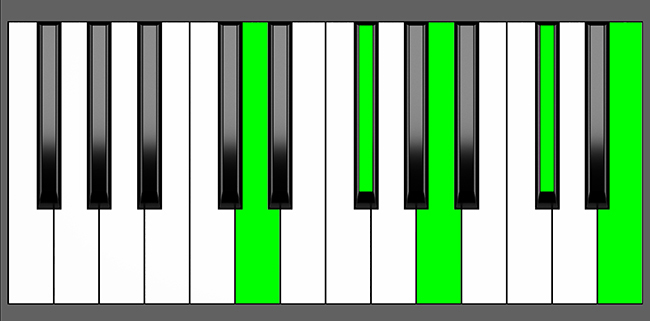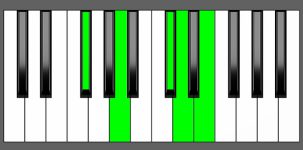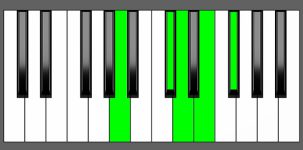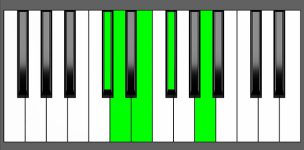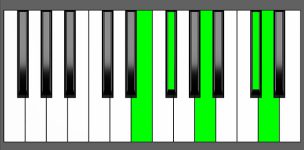Piano Diagram of D Maj9 in Root Position
A D Maj9 chord is a type of chord that consists of a major seventh chord combined with a major ninth note. This chord is built upon a D major scale, and it includes the notes D, F#, A, C#, and E. Keep reading to get a better grip on the music theory behind this chord.
Structure of D Maj9
Notes |
|---|
| D, F#, A, C#, E |
Intervals |
|---|
| R, 3, 5, 7, 9 |
Playing Extended Chords on Piano
Extended chords are commonly used in piano playing, but they can be tricky to play in their entirety due to the large number of notes involved. To make these chords more manageable, pianists often omit certain notes, such as the root or the 5th. Another technique is to split the chord between both hands, playing either full or partial chords in each hand.
However, even when notes are omitted or split between hands, extended chords can still create complex and dense harmonies. When these chords are inverted, the resulting clusters of notes can be particularly challenging to voice effectively.
D Maj9 Chord Inversions
The D Maj9 chord has a total of 4 inversions:
| Root Position: | D | F# | A | C# | E |
| 1st Inversion: | F# | A | C# | D | E |
| 2nd Inversion: | A | C# | D | E | F# |
| 3rd Inversion: | C# | D | E | F# | A |
| 4th Inversion: | E | F# | A | C# | D |
Piano Keyboard Diagrams
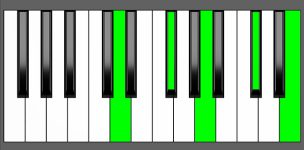
Chord Inversions on Piano
Chord inversions are a fundamental concept in music theory, as they help to understand how chords are constructed and how they can be used in progressions. When discussing chord inversions on a piano keyboard, it is important to note that the diagrams showing the sequence of notes in an inversion may not always correspond to practical playing.
In practical playing, proper chord voicings involve spreading the notes of the chord across different octaves and positions on the keyboard, which may not necessarily match the basic shape of the chord’s inversions as depicted in diagrams. Therefore, while chord inversion diagrams help understand the structure and sequence of notes in a chord, they may not always provide the most efficient way to play the chord on a piano keyboard.
As a pianist, it is important to experiment with different voicings and fingerings of chords to find the most comfortable and efficient way to play them, while still maintaining the intended harmonic function and sound.
Music Theory and Harmony of D Maj9
Building the D Maj9 Chord: Different Approaches
Starting from the D Major Scale
If you want to create a major 7/9 chord, the major scale is a useful reference point. You will need to combine five notes: the Root note, a major 3rd, a 5th interval, a major 7th, and a major 9th.
For instance, to build the D Maj9 chord, you can start with the D Major scale.


To form a D Maj9 chord, use the formula R, 3, 5, 7, 9 as follows:
- Start with the Root note, D.
- Choose the major 3rd interval, which is F#, and include it in the chord.
- Add the 5th interval, A.
- Include the major 7th interval, C#.
- Lastly, add the 9th, E.
By using this straightforward formula, you can produce a major 7/9 chord from any major scale.
by Combining Intervals
To build a major 9th chord, you can use a combination of specific intervals – a major 3rd, a minor 3rd, another major 3rd, and a final minor 3rd.
3 + m3 + 3 + m3 = Major 9th Chords
For instance, we can take the D Maj9 chord as an example.
When we examine the intervals between the notes in this chord, we can see that:
- D-F# forms a major 3rd interval,
- F#-A creates a minor 3rd interval,
- A-C# is a major 3rd,
- and finally, C#-E forms a minor 3rd interval.
By stacking these five intervals together, we can create the D Maj9 chord.
by Combining Chords
Another trick to build a Maj9 chord is by combining a major triad with the major chord built on its fifth note.
To create a D Maj9 chord, for instance, you can combine a D Major triad (D, F#, A) with an A Major chord (A, C#, E). These two chords share the note A, and when played together, they form a D Maj9 chord.
D Major + A Major = D Maj9
How to Use D Maj9 in a Chord Progression
These tables show the harmonized major and natural minor scales that contain a D Maj7 chord replaceable with a D Maj9.
The D Maj9 chord can be used as the first (I) chord in the D major scale, and it can also serve as the subdominant chord in the A major scale. In the natural minor scales, it functions as the third (mediant) chord in the B natural minor scale and as the sixth (submediant) chord in the F# natural minor scale.
on Major Scales
| Major Scales | I | ii | iii | IV | V | vi | vii |
|---|---|---|---|---|---|---|---|
| D | D Maj7 ⇒ D Maj9 | E min7 | F# min7 | G Maj7 | A7 | B min7 | C#m7b5 |
| A | A Maj7 | B min7 | C# min7 | D Maj7 ⇒ D Maj9 | E7 | F# min7 | G#m7b5 |
- Tonic chord in D Major
- Subdominant chord in A Major
on Natural minor Scales
| Minor Scales | i | ii | III | iv | v | VI | VII |
|---|---|---|---|---|---|---|---|
| B | B min7 | C#m7b5 | D Maj7 ⇒ D Maj9 | E min7 | F# min7 | G Maj7 | A7 |
| F# | F# min7 | G#m7b5 | A Maj7 | B min7 | C# min7 | D Maj7 ⇒ D Maj9 | E7 |
- Mediant chord in B minor
- Submediant chord in F# minor
D Maj9 Chord Function in Major and Minor Keys
Understanding Scale Degrees
When we create chords based on a scale, each note is assigned a degree that reflects its position within the scale. These degrees act as a map to help us navigate the harmonic landscape of music.
- Starting with the first degree, we have the Tonic chord, which sets the tonal center of the music. This chord gives a sense of stability and serves as a reference point for all other chords and notes in the scale.
- Moving to the second degree, we have the Supertonic, which connects the tonic to other notes in the scale. This degree creates a sense of movement and tension, pushing the music forward.
- The third degree is the Mediant, which sits between the tonic and dominant notes. This degree establishes the scale’s mode (major or minor) and influences the music’s emotional character.
- The fourth degree is the Subdominant, which balances the dominant. This degree adds complexity to the music by creating a sense of tension and release.
- The fifth degree is the Dominant, which generates tension and anticipation. This chord is often used to resolve back to the tonic, creating a sense of closure.
- Moving on to the sixth degree, we have the Submediant, which creates a feeling of relaxation and stability. This degree acts as a transition between the dominant and tonic chords, creating balance and resolution.
- Lastly, we have the seventh degree, the Leading tone, which generates tension and dissonance. This degree wants to resolve to the tonic, giving the music a sense of finality.
D Maj9 as the Tonic Chord in D Major
A Major 9th chord could be used in place of the first chord in the harmonized D major scale. In a major key, the I chord (built on the first degree of the major scale) serves as the tonic chord, providing the harmonic center of the chord progression. If we take the D major scale and harmonize it using the notes of the scale, we get the following chords:
| I | ii | iii | IV | V | vi | vii |
| D Maj7 | E min7 | F# min7 | G Maj7 | A7 | B min7 | C#m7b5 |
D Maj9 Chord Progressions as I degree
Try playing these chord progressions to get an idea of how D Maj9 functions as the tonic (I degree) in a chord progression.
II V I
| ii | V | I |
| E min7 | A7 | D Maj9 |
I IV V
| I | IV | V |
| D Maj9 | G Maj7 | A7 |
I V vi IV
| I | V | vi | IV |
| D Maj9 | A7 | B min7 | G Maj7 |
I IV vi V
| I | IV | vi | V |
| D Maj9 | G Maj7 | B min7 | A7 |
D Maj9 as Subdominant Chord in A Major
The D Maj9 chord can also be found on the fourth degree of the A major scale. In the I-IV-V progression, the chord on the fourth degree serves as a transitional chord between the first and fifth degrees.
| I | ii | iii | IV | V | vi | vii |
| A Maj7 | B min7 | C# min7 | D Maj7 | E7 | F# min7 | G#m7b5 |
D Maj9 as IV degree – Chord Progressions
Try playing these chord progressions to get an idea of how D Maj9 functions as the subdominant (IV degree) in a chord progression.
I IV V
| I | IV | V |
| A Maj7 | D Maj9 | E7 |
I V vi IV
| I | V | vi | IV |
| A Maj7 | E7 | F# min7 | D Maj9 |
I IV vi V
| I | IV | vi | V |
| A Maj7 | D Maj9 | F# min7 | E7 |
D Maj9 as the Mediant Chord in B minor
Likewise, if we consider the B natural minor scale we can locate the D Maj9 chord as the third degree.
| i | ii | III | iv | v | VI | VII |
| B min7 | C#m7b5 | D Maj7 | E min7 | F# min7 | G Maj7 | A7 |
D Maj9 as III degree – Chord Progressions
These chord progressions can help you comprehend how D Maj9 serves as the mediant (III degree).
i III
| i | III |
| B min7 | D Maj9 |
i III iv v
| i | III | iv | v |
| B min7 | D Maj9 | E min7 | F# min7 |
i III ii v
| i | III | ii | v |
| B min7 | D Maj9 | C#m7b5 | F# min7 |
I iii vi V
| i | III | VI | iv |
| B min7 | D Maj9 | G Maj7 | E min7 |
i III VII VI
| i | III | VII | VI |
| B min7 | D Maj9 | A7 | G Maj7 |
Circle Progression
| i | iv | VII | III | VI | ii | V7 | i |
| B min7 | E min7 | A7 | D Maj9 | G Maj7 | C#m7b5 | F#7 | B min7 |
D Maj9 as the Submediant Chord in F# minor
Another instance where you can come across a D Maj9 chord is while playing in the key of F#. In fact, the D Maj9 chord can be found on the sixth degree of the F# minor scale.
| i | ii | III | iv | v | VI | VII |
| F# min7 | G#m7b5 | A Maj7 | B min7 | C# min7 | D Maj7 | E7 |
D Maj9 as VI degree – Chord Progressions
Try playing these chord progressions to get a sense of how D Maj9 sounds as the submediant (VI degree).
i VI VII
| i | VI | VII |
| F# min7 | D Maj9 | E7 |
i v VI VII
| i | v | VI | VII |
| F# min7 | C# min7 | D Maj9 | E7 |
i III VII VI
| i | III | VII | VI |
| F# min7 | A Maj7 | E7 | D Maj9 |
Circle Progression
| i | iv | VII | III | VI | ii | V7 | i |
| F# min7 | B min7 | E7 | A Maj7 | D Maj9 | G#m7b5 | C#7 | F# min7 |
Alternative Names for D Maj9 Chord
- D ∆9
- D M9
- D j7/9
- D Δ7/9
- D maj9
- D Maj9
- D M7/9
- D Ma7/9
- D major7/9
Conclusion
The chord progressions and examples presented in this post provide a comprehensive overview of the most common uses of the D Maj9 chord. It’s important to note, however, that many advanced harmony-related topics could not be included due to space constraints. These topics include chord progressions built on harmonic and melodic scales, modal scales, hidden tonality, secondary dominants and other chord substitutions, non-functional harmony and atonal music, modal interchange and borrowed chords, voice leading and counterpoint, chromatisms, jazz harmony…I mean, music theory is a huge topic!
Although I couldn’t cover all of these topics in my post, I encourage readers to continue exploring these areas in their own study and research. By expanding your knowledge in these advanced areas of music theory, you can gain a deeper understanding of the harmonic possibilities that exist beyond the basics presented here.
